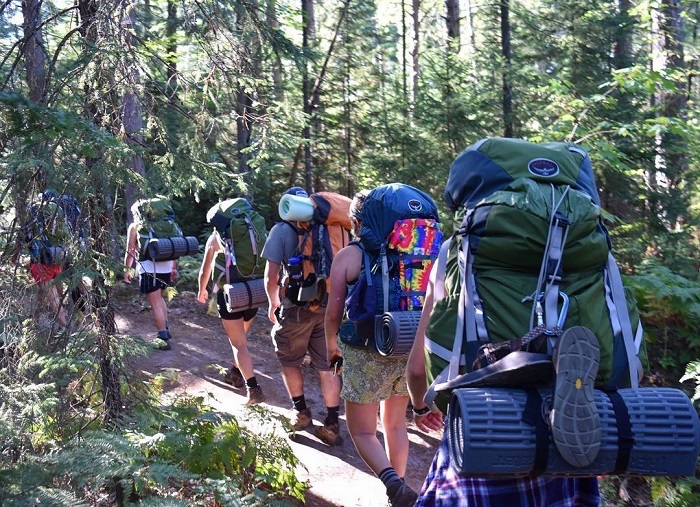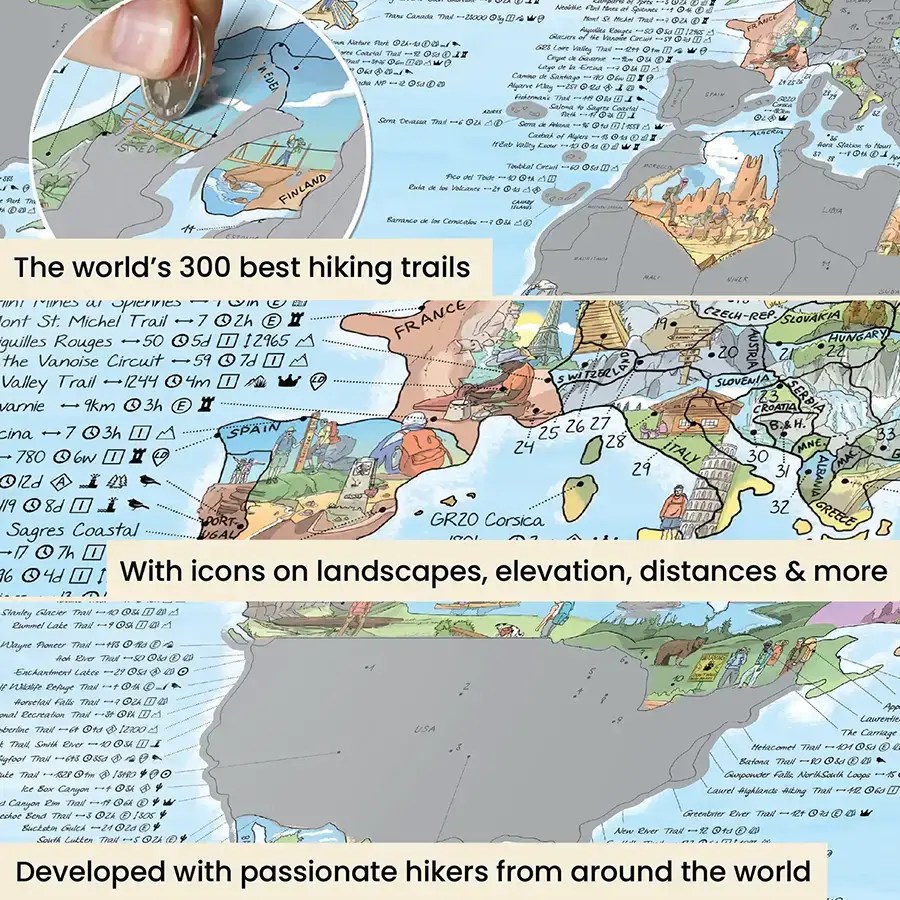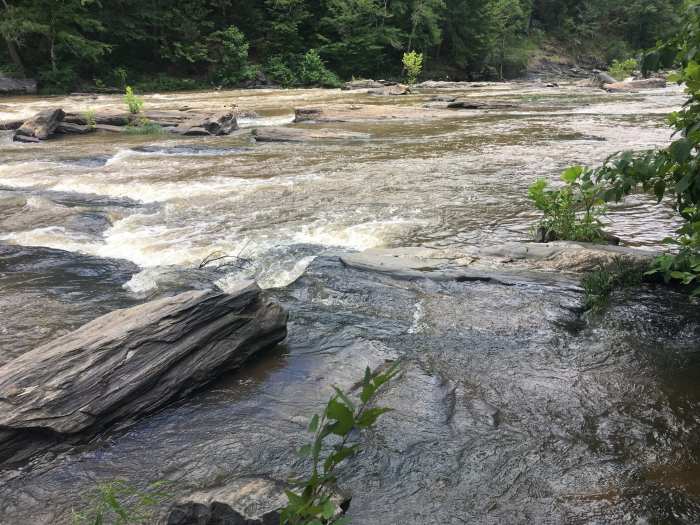Hiking parks near me: Discover breathtaking trails and scenic vistas just a short drive away. This guide helps you find the ideal hiking park, from national treasures to local gems, catering to every skill level and preference. We’ll explore various park types, highlight key amenities, and provide essential information for a safe and enjoyable outdoor experience.
Whether you’re seeking a challenging climb or a leisurely stroll through nature, our comprehensive search tool helps you find the perfect hiking park near you. We’ll guide you through locating parks based on your location, specifying a search radius, and understanding the different types of parks available. We’ll also discuss the key features to consider, like amenities, trail types, and accessibility.
Finally, we’ll show you how to utilize reviews, ratings, and park information to make the best choice.
Defining the Search Area

Source: michigan.org
Locating nearby hiking parks requires a precise understanding of the user’s position and the desired search radius. Accurate location data is crucial for delivering relevant results. This process also needs to be adaptable to varying user preferences, including different units of measurement and multiple region searches. Efficiently handling these factors ensures a seamless and informative search experience.
User Location Identification
Precise location identification is essential for relevant hiking park recommendations. Utilizing GPS-enabled devices or browser-based location services are common methods. Mobile apps and websites can leverage these technologies to determine the user’s current coordinates. This allows for targeted searches that are specific to the user’s immediate surroundings. Furthermore, users may input their location manually for greater precision.
Search Radius Specification, Hiking parks near me
The search radius defines the distance from the user’s location within which hiking parks will be displayed. Providing a range of units is crucial for user convenience. Common units include miles and kilometers. Users should have the option to specify the radius in their preferred unit. A flexible search radius allows users to explore hiking options near their location, whether they want to discover local parks or explore a wider area.
Handling Searches Across Multiple Regions/States
Searches spanning multiple regions or states can be handled by enabling users to specify multiple locations or regions in their search criteria. This could involve inputting a series of addresses or using geographic coordinates. This function allows users to explore hiking parks in a broader area, which is valuable for users with interests in different regions. The system should be able to handle various input methods, ensuring ease of use for the user.
Dynamic Radius Adjustment
The search radius should adapt to user input. If a user enters a very broad search radius, the search results might be overwhelming. Conversely, a narrow radius might yield few or no results. The system should dynamically adjust the search radius based on the user’s input, providing a manageable set of results that cater to the user’s search intentions.
This ensures that the user receives results relevant to the scope of their search.
Finding hiking parks near me can be a rewarding experience, but knowing where to start can be overwhelming. Fortunately, exploring the best places to hike near me is made easier with resources like best places to hike near me. This research can help pinpoint the ideal hiking parks near you, ensuring a memorable and enjoyable outdoor adventure.
Search Area Specification Table
| Location | Radius Options | Region/State |
|---|---|---|
| User’s Current Location (GPS) | Miles, Kilometers | Single region/state |
| Specific Address | Miles, Kilometers | Single region/state |
| Multiple Addresses | Miles, Kilometers | Multiple regions/states |
| Geographic Coordinates | Miles, Kilometers | Multiple regions/states |
Types of Hiking Parks

Source: travelandleisure.com
Hiking parks offer diverse experiences, catering to varying preferences and needs. Understanding the different types, their characteristics, and amenities is crucial for selecting the ideal park for a specific hike. This exploration will detail the various categories of hiking parks, highlighting their unique features and accessibility.
Classifying Hiking Parks
Hiking parks encompass a wide spectrum, ranging from expansive national preserves to intimate city-based recreational areas. This categorization allows for tailored planning based on desired experiences and resources.
Types of Parks and Their Characteristics
Different types of hiking parks offer varying degrees of amenities and access levels. National parks, for instance, are often renowned for their vast wilderness and natural beauty, but they may present more challenging access requirements. Conversely, city parks provide convenient proximity and accessible facilities but may feature more limited wilderness areas.
- National Parks: These parks are often federally managed, safeguarding significant ecological and historical landmarks. They typically boast extensive trails, diverse ecosystems, and abundant wildlife. Amenities may be limited in certain areas, with access sometimes requiring permits or reservations. Examples include Yosemite National Park and Glacier National Park, where the vastness and unique features often necessitate careful planning.
- State Parks: State parks, often managed at the state level, offer a balance between natural beauty and accessibility. They typically feature a range of trails, from easy strolls to challenging climbs, and offer various facilities, such as picnic areas and restrooms. Access is generally easier compared to national parks, but availability of amenities may differ.
- City Parks: Urban parks provide convenient access for local residents and visitors. They are often smaller in scale and may have trails catering to various skill levels. Amenities like restrooms, playgrounds, and even cultural centers are frequently present, making them ideal for shorter hikes or family outings. Examples include Central Park in New York City and Golden Gate Park in San Francisco.
- Regional Parks: Regional parks, managed by a governing body larger than a city but smaller than a state, provide a balance between accessibility and wilderness experience. They often cater to a specific region and offer a blend of amenities and natural beauty, ranging from hiking trails to nature centers.
Amenities and Facilities
The range of amenities and facilities within each park type significantly influences the overall experience. National parks may have limited facilities, especially in remote areas, whereas city parks offer extensive amenities.
Accessibility Levels
Access levels vary considerably across park types. National parks, often with rugged terrains and remote locations, may require more preparation and physical exertion for access. City parks, on the other hand, offer convenient and readily accessible trails.
| Park Type | Features | Accessibility |
|---|---|---|
| National Parks | Vast wilderness, diverse ecosystems, abundant wildlife, extensive trails | May require permits/reservations, varying levels of difficulty |
| State Parks | Balanced natural beauty and accessibility, variety of trails | Generally easier access than national parks |
| City Parks | Convenient location, smaller scale, various skill-level trails, extensive amenities | Highly accessible, readily available trails |
| Regional Parks | Balanced accessibility and wilderness, varying degrees of amenities and natural beauty | Typically balanced access and amenities compared to others |
Features and Amenities
Hiking parks are more than just trails; they offer a multifaceted experience. The availability and quality of amenities significantly impact the overall enjoyment and safety of hikers. Understanding these features allows for informed decisions about which parks best suit individual needs and preferences. Accessibility and convenience play a crucial role in determining the overall experience.
Popular Amenities and Their Importance
Essential amenities enhance the hiking experience, from convenient parking to accessible restrooms. These features contribute to a positive and safe environment for hikers of all skill levels. Proper facilities and trail maintenance are vital for both the enjoyment and safety of park visitors.
- Restrooms: Clean and readily available restrooms are crucial for the comfort and safety of hikers, particularly on longer trails. Their presence minimizes issues and allows for a more enjoyable experience.
- Water Fountains: Access to fresh water is essential for hydration, especially during strenuous hikes. Water fountains provide convenient access to potable water, preventing dehydration and promoting overall well-being.
- Parking: Adequate parking facilities are critical to accommodate the anticipated number of visitors. Efficient parking minimizes congestion and allows for a smoother entry into the park.
- Trails: Well-maintained trails are fundamental to a safe and enjoyable hiking experience. The quality of trails, including their surface, width, and markings, significantly influences the experience.
Comparative Analysis of Amenities Across Different Park Types
Different types of hiking parks cater to various needs and preferences. The availability and quality of amenities will differ depending on the park’s intended use and the surrounding environment. This analysis demonstrates the variance in amenities between various park types.
| Park Type | Restrooms | Water Fountains | Parking | Trails |
|---|---|---|---|---|
| Urban Parks | Often frequent, with modern facilities | Usually available, potentially limited | Limited parking, often with permit systems | Shorter trails, often within city limits |
| Suburban Parks | Usually available, varying in quality | Generally available, but potentially fewer than urban parks | Moderate parking availability | Variety of trail lengths and difficulty |
| National Parks | Available but may be spaced further apart | Often available, but may need to carry water | Significant parking, sometimes with overflow areas | Extensive trails, varying difficulty levels and lengths |
Evaluating Park Suitability for Different Hikes
Assessing a park’s suitability for a particular hike involves careful consideration of various factors. The specific needs of a hiker (like experience level, duration of hike, and expected weather) should be factored into the selection process.
- Distance: The distance of the trail should align with the hiker’s physical capabilities. Longer hikes require more planning and preparation.
- Difficulty: Trail difficulty levels should match the hiker’s experience and fitness level. Overestimating or underestimating the difficulty can lead to disappointment or injury.
- Terrain: The terrain of the trail should be evaluated for safety and enjoyment. Steep inclines or rocky sections require extra caution.
Types of Trails
Hiking trails vary in their features and challenges. Understanding the different types available enables hikers to choose trails that match their preferences.
- Loop Trails: These trails offer a circular route, allowing hikers to return to the starting point without retracing their steps.
- Out-and-Back Trails: These trails offer a one-way journey to a designated point, followed by a return to the starting point.
- Multi-use Trails: These trails can be used for hiking, biking, and other activities. Hikers should be aware of potential conflicts with other users.
Filtering and Sorting Options

Source: thetravelimages.com
A robust search engine for hiking parks must offer sophisticated filtering and sorting mechanisms to streamline the user experience and ensure relevant results. This allows users to quickly pinpoint the perfect trail based on their preferences, saving them time and effort. Effective filtering and sorting also enhances the user interface’s overall usability.Comprehensive filtering and sorting empower users to refine their search, ensuring they find hiking parks that precisely match their needs.
This personalized approach improves the user journey, leading to greater satisfaction and potentially increased engagement with the platform. The ability to apply multiple filters simultaneously allows users to further narrow down their choices, maximizing the likelihood of finding a perfect match.
Difficulty Level Filtering
Users need to easily filter hiking parks by difficulty level. Offering options like “easy,” “moderate,” and “challenging” provides clear distinctions for different skill levels and preferences. This feature caters to a diverse range of hikers, from beginners to seasoned adventurers. Such filtering options ensure that users find trails that align with their physical capabilities.
Distance, Popularity, and Recent Review Sorting
Users should have the ability to sort results based on criteria such as distance from their location, popularity (e.g., number of visits), or recent user reviews. Distance sorting is critical for users prioritizing proximity. Popularity sorting helps users discover the most frequented and likely enjoyable trails. Sorting by recent reviews provides insight into current experiences and potential issues.
Multiple Filter Application
The platform must support the simultaneous application of multiple filters. Users should be able to combine difficulty level, distance, popularity, and other criteria to refine their search and locate the ideal hiking park. This allows users to narrow their search to a specific subset of options.
Discovering hiking parks near you offers a fantastic opportunity for outdoor exploration. Understanding the core principles of hiking, such as the techniques and considerations outlined in the Hiking Definition , is key to planning a safe and rewarding experience. These parks provide excellent locations for practicing these skills and enjoying the natural beauty of the local environment.
User Preferences
User preferences should be tracked and accommodated to provide a personalized experience. This can involve remembering past searches and automatically applying previously selected filters for future searches. This level of personalization enhances user experience and retention. By incorporating these preferences, the system learns the user’s habits and preferences.
Illustration of Sorting and Filtering Options
| Sorting Criteria | Filtering Options | Example |
|---|---|---|
| Distance | Within 5 miles, 10 miles, 25 miles | User wants trails within 10 miles of their location. |
| Popularity | High, Medium, Low | User seeks popular trails. |
| Difficulty | Easy, Moderate, Challenging | User prefers moderate difficulty trails. |
| Recent Reviews | Positive, Mixed, Negative | User seeks trails with overwhelmingly positive recent reviews. |
Reviews and Ratings
User reviews and ratings are crucial for enhancing the user experience and providing valuable insights into the quality and appeal of hiking parks. Accurate and trustworthy feedback allows potential visitors to make informed decisions, leading to a more enjoyable and rewarding experience. This section delves into the critical role of reviews and ratings in park selection, emphasizing how to incorporate and evaluate such feedback effectively.
Incorporating User Reviews
User reviews provide a direct window into the real-world experiences of other hikers. Integrating these reviews into the search engine allows users to quickly assess the overall atmosphere, the trail conditions, and the amenities offered at each park. This integrated approach facilitates a more nuanced and complete understanding of the park, going beyond simple descriptive text. Potential visitors can draw direct comparisons between different parks based on user experiences.
Importance of Reviews in Park Selection
Reviews act as a vital compass in the decision-making process for potential visitors. They offer a tangible glimpse into the park’s character, providing insights into aspects that standard park descriptions may overlook. The detailed narratives, and the quantitative ratings, provide crucial information for assessing the suitability of a park for a particular individual’s needs and preferences. This crucial data significantly influences the decision-making process.
Displaying User Reviews
A structured format for presenting reviews enhances usability. A clear layout, incorporating elements like the reviewer’s username, rating, and date of the review, allows for efficient filtering and sorting. A concise summary of the review, allowing for rapid skimming, is essential. The inclusion of visual elements, such as stars or emojis, alongside numerical ratings further enhances the user experience.
Evaluating Review Credibility
Assessing the credibility of user reviews is essential for avoiding bias and ensuring accuracy. Reviews should be evaluated based on factors such as the reviewer’s profile, the context of the review, and the overall tone. A review from a seasoned hiker with a history of positive contributions is likely to be more trustworthy than a review from a new user with limited experience.
Organizing Reviews by Rating and Date
A tabular format is ideal for organizing reviews by rating and date. This approach allows for a clear and comprehensive overview of the park’s reputation over time. The table should clearly delineate columns for rating, date, reviewer, and the review text itself. Such a structured presentation streamlines the review-reading process.
| Rating | Date | Reviewer | Review |
|---|---|---|---|
| 5 Stars | 2024-10-27 | ExperiencedHiker | Excellent trails, well-maintained facilities, and stunning views. Highly recommend! |
| 4 Stars | 2024-10-26 | NatureLover | Beautiful park, but some sections of the trail could use more maintenance. |
| 3 Stars | 2024-10-25 | FirstTimer | Nice park, but the parking lot was very crowded. |
Park Information and Accessibility: Hiking Parks Near Me
Comprehensive park information is crucial for users to make informed decisions and ensure safe and enjoyable experiences. Clear guidelines, detailed maps, and accessibility details are vital for all park visitors. This section details the essential information needed to create a user-friendly and inclusive online platform for discovering and navigating local hiking parks.Providing detailed park information empowers users to plan their outings effectively.
Users can make informed decisions about their trips based on the rules, regulations, and potential challenges presented by the park.
Finding hiking parks near me is a great way to enjoy nature. However, for a more immersive experience, exploring hiking camping trails near me, such as those detailed in this guide hiking camping trails near me , can significantly enhance your outdoor adventures. Ultimately, whether you opt for a simple hike or a more involved camping trip, discovering hiking parks near you offers a rewarding way to connect with the natural world.
Park Rules, Regulations, and Directions
Park rules and regulations are essential for maintaining the safety and integrity of the environment. Clearly defined rules prevent conflicts and ensure that all visitors understand their responsibilities. Directions, including parking instructions and access points, are critical for efficient navigation. This information helps users find the park quickly and safely.
Finding hiking parks near me is crucial for outdoor enthusiasts. Exploring local nature reserves often reveals hidden gems, but discovering the best trails is key. For instance, checking out nice trails near me can illuminate the perfect pathways for a refreshing hike. Ultimately, finding hiking parks near me is simplified with this type of targeted research.
| Park Name | Rules and Regulations | Directions | Parking Information |
|---|---|---|---|
| Oak Ridge Park | No pets allowed in designated areas, stay on marked trails, dispose of trash properly. | Take Highway 101 North, exit at Oak Ridge Rd, follow signs for park entrance. | Limited parking available, consider alternative transportation options during peak hours. |
| Silver Creek Preserve | Fire bans in effect during dry seasons, no motorized vehicles allowed, stay on marked trails. | Follow signs from the main highway, turn right onto Preserve Road, park at designated area. | Plenty of parking, accessible from multiple entrances. |
| Redwood Canyon | Stay on designated trails, pack out all trash, be aware of wildlife, and maintain a safe distance from animals. | Drive to the trailhead, follow the signage, and park at the designated parking area. | Limited parking, first-come, first-served basis. |
Park Maps
Park maps are indispensable tools for visitors. Visual representations of the terrain, trails, and key features aid in planning and navigation. Effective map presentation enhances user understanding of the park layout and encourages safe exploration.Clear and detailed maps are vital for a positive visitor experience. The layout should be intuitive, with clear trail markings, elevation changes, and prominent landmarks.
The map should also include accessibility features, such as ramps and paved paths. Interactive maps that allow users to zoom, pan, and mark locations are highly beneficial.
Visual Representation of Results
A compelling user experience hinges on effectively presenting search results. Visual representations, particularly maps and images, enhance understanding and engagement, guiding users seamlessly through the vast landscape of hiking parks. A well-designed visual interface fosters exploration and encourages users to delve deeper into the available options.A robust search interface should display nearby hiking parks in a clear and accessible manner.
Users need a quick and intuitive method for understanding the park’s location and proximity to their current position. This requires a visually engaging representation, seamlessly integrating maps with park information.
Displaying Nearby Parks
The display of nearby parks should prioritize clarity and user-friendliness. A map interface, prominently displaying parks as distinct markers, is crucial. Each marker should be easily identifiable, representing the park’s name and potentially offering a brief overview of key characteristics. Consider using varying marker symbols or colors to differentiate park types (e.g., urban parks, nature preserves, national parks).
Presenting Park Trails
Displaying trails within parks on an interactive map is essential. Trails should be clearly visualized, perhaps using different colors or line weights to differentiate difficulty levels or trail types. Interactive elements, such as zooming and panning, are critical for allowing users to explore the trail network in detail. Overlaying trail information directly onto the map, providing details about trail length, elevation gain, and difficulty, further enhances the user experience.
This ensures users have a comprehensive understanding of the trails before committing to a hike.
Presenting Park Images
High-quality images of the parks are essential for attracting users. A carousel or gallery-style display, allowing users to quickly browse through various park images, will showcase the beauty and appeal of each location. The images should be visually appealing and representative of the park’s features. Images should clearly depict the terrain, surrounding environment, and any noteworthy landmarks or features.
Consider including multiple images per park, showcasing different perspectives or seasons.
Incorporating Interactive Elements
Interactive elements are key to enhancing the user experience. Zooming functionality allows users to explore the map in detail, revealing finer details of trails and parks. Panning functionality facilitates seamless navigation across the map, enabling users to quickly move between different locations. Tooltips, or pop-up boxes, should appear when users hover over a park marker, providing additional information about the park’s features.
Integration with external services like weather forecasts or trail reviews, displayed as part of the park information, would provide a more comprehensive experience. Implementing these interactive features would significantly enhance the usability and overall appeal of the hiking park search platform.
Epilogue
In conclusion, finding the ideal hiking park near you is easier than ever with this comprehensive guide. By understanding your location, park types, features, and utilizing filtering and sorting options, you can quickly identify the perfect spot for your next outdoor adventure. Remember to always check park rules, regulations, and accessibility before heading out. Enjoy your hike!
FAQ Resource
What types of hiking parks are available?
Hiking parks come in various forms, including national parks, state parks, city parks, and even local conservation areas. Each type offers unique amenities and access levels.
How can I filter parks by difficulty?
You can filter parks by difficulty level, such as easy, moderate, or challenging, ensuring you choose a trail appropriate for your experience.
What information is provided about park accessibility?
Park information will include details on accessibility for people with disabilities, helping ensure inclusivity and ease of access.
How do I use reviews and ratings to choose a park?
Reviews and ratings from other hikers provide valuable insights into a park’s features, trail conditions, and overall experience, helping you make an informed decision.





Leave a Reply